Zoe’s Status Report – 4/27/24
This week, I got the Bluetooth signal to work between the mat and the lock. I bought a new BLE module (an HM-10) to replace our old part because it wasn’t applicable to what we were doing. This one was the most recommended BLE module for Arduino Uno R3 according to multiple websites online and had comprehensive documentation online that made understanding its AT commands easy. I added client code to the mat XIAO ESP3S3 and made the HM-10 module act as a server. So, the app acts as a client for the mat server, and the mat acts as a client for the lock server. I ran the entire data pipeline from song choice on app to song received on lock, and I did not run into any issues with data transfer as long as the devices are all initialized correctly. While doing this work I also worked on updating the mat code and making it more readable for Brooke and Jada, because they will need to understand it while doing integration.
I am on time with my work, because I got Bluetooth to work for the whole system, which I needed to do by the end of this week. All I need to do this week is finish the mat code to update the dance logic (as explained in the Team update) and edit the code to be readable for Brooke and Jada. Since I am in New Hampshire this week for a competition, I will help them virtually with the system integration, communicating over calls and sending code updates if required. In addition, I will help with the final poster.
Team Status Report – 4/27/24
- What are the most significant risks that could jeopardize the success of the project? How are these risks being managed? What contingency plans are ready?
The most significant risk during this final week will be running into any unforeseen complications as we finish system integration. This is finals week, so as much as we would like to be able to devote every waking hour to finishing the project, we have other finals, job interviews, and projects to complete this week. Issues will be managed, thus, on a priority scale basis; for example, if Bluetooth between the mat and lock malfunctions, we should be able to quickly physically wire the two systems together.
- Were any changes made to the existing design of the system (requirements, block diagram, system spec, etc)? Why was this change necessary, what costs does the change incur, and how will these costs be mitigated going forward?
Come Monday, there may be a new change to the lock, as mentioned in Jada’s status report. This change, if successful, will allow for a smaller lock footprint, better audio quality, and slightly more amplification; this change will incur minimal costs.
As seen in Brooke’s report, the board design underwent many changes to fix some strength and quality issues. A new system to distribute weight was added, and the pads were replaced with much stronger wood.
The mat dance will now be encoded based on the times between steps instead of the times of steps to account for the fact that we don’t know exactly when the songs will play, because the Bluetooth connection timing is not exactly consistent. In addition, an HM-10 BLE 4.0 module will now be used for the lock Arduino Uno R3.
List all unit tests and overall system test carried out for experimentation of the system. List any findings and design changes made from your analysis of test results and other data obtained from the experimentation.
For the lock, the following items were tested: keypad functionality, servo functionality, SD card reader functionality along with song selection, Bluetooth module functionality, and speaker decibel levels. For the speaker, decibel readings were completed using an iPhone dB reader app in a moderately quiet room at 6″, 1′, 2′, and 3′ away from the uncovered speaker. Our goal was to have the speaker audible but no greater than 75 dB for safe hearing, and the current complete system achieves this specification. However, since the speaker will soon be covered, we are trying to amplify the speaker a little more to be at around 70 dB when covered.
For the dance mat, the strength and detection of steps were tested. Unfortunately, the original design of the pads was faulty in nicely distributing the weight and having strength for heavy weights, so we upgraded the final pads to newer and thicker plywood at around 12mm in thickness each. After this, things performed much better, with complete detection of the weights required and the strength to handle heavy weights and sudden strong forces of steps.
For the app, tests were conducted to measure how long it took for the app to connect to the mat. I ran each test 5 times for 6” distance, 1 foot distance, 2′ distance, 4′ distance (all on the floor), and standing height (around 4′ distance) above the mat microcontroller. I only tested without the antenna extension, because we could not access the extension at that time. The results from this test suggested that the antenna extension should be used, to ensure long distance connection is possible.
Brooke’s Status Report – 4/27/24
This week has been a pretty busy one, with the board being finally assembled, minus the outside of it. I was not expecting many changes to be made this week, such as getting all-new wood for the pads of the board and getting rid of the usage of polycarbonate due to the quality of the polycarbonate pieces. Another change made was to get rid of a portion of the inner walls of the board and replace them with doorstop pads to softly distribute the weight on the board and support the high weights that we expect on the board. One final change I may try to make tomorrow is to use a stack of three batteries instead of the single battery I am using now to significantly increase the battery life.
With that said, we are currently on track to finish everything and present the project. So next week will be the final touches on the board as well as refining a lot of the firmware to make sure the board functions with high accuracy and double checking with some extra testing. Besides this, the other things I plan to complete/work on are the final paper and preparing for the demo day that is coming up. Below, I have attached a photo of the current state of the board with my foot as a reference. The final board will look different from this, though, as the outside tape and rubber have not yet been added.

As said in the team report, I tested the strength and detection of steps on the board. Unfortunately, the original design of the pads was faulty in nicely distributing the weight and had strength issues. This is what led to the new and improved pads made of thicker plywood at around 12mm in thickness each. After this, things performed much better, with complete detection of the weights required and the strength to handle heavy weights and sudden strong forces of steps.
Jada’s Status Report – 4/27/24
This week, I was able to fully integrate the servo motor as the locking mechanism. Quite a bit of iteration was required in getting the code to work, but I was also able to implement a locking function whereby the servo will move to the locked position whenever the “*” button on the keypad is pressed. This can be done at any point in the system, allowing for the user to lock their door easily. I also did research on linear actuators to attach to the servo motor to exhibit more of a “locking” behavior during the public demo next week. With Brooke, we 3D printed a linear actuator that I found on Thingiverse .
I also presented the final presentation, which took a bit of time to prepare for at the start of last week, in addition to losing two class periods to listening to presentations. Earlier this week, I also helped Brooke with choosing new materials for the mat after running into issues with materials flexing too little or too much. During this time, we consulted one of the wood shop operators in Techspark as well as my father, who works with polyurethane, to get an opinion on what materials and pliability we should be aiming for.
The other main thing I have been working on was testing and integrating a new DAC-amp module that Brooke ordered. During initial testing, I believe I found a hardware malfunction and read of a shortcut on an online forum that will circumvent this issue. This worked in testing the sound quality and amplification ability (which is much better than the amplifier circuit I built earlier), however, the functionality of choosing songs and setting the volume still does not work, as the shortcut does not address the main issue of connecting properly. This is an issue, as it won’t allow for song selection, will shuffle through the mp3 files endlessly, and is much too loud for our application. I am going to ask Brooke to take a look at it tomorrow, although I don’t plan to spend much more time on it, as the amplifier circuit works fine enough for the demo.
By Monday, I will settle either on the DAC-amp module or the amplifier circuit so that I can laser-cut the final lock housing and secure the servo in its linear actuator. I will also integrate the new BT module that Zoe ordered to work with the mat’s BT signal (this module is different from the one I originally tested, but did not work for Zoe in testing communication between the Seeed and the lock module).
I definitely feel that I am behind schedule, due to these new modules I am trying to implement not allowing me to finish the lock housing and work solely on the mat with Brooke. This week will be spent getting everything put together for the demo. As mentioned above, I will have settled on the lock electronics and cut out the housing by Monday. I will also be helping Zoe with the poster that is due Tuesday, and working with Brooke to produce the video by Thursday.
Team Status Report – 4/20/24
- What are the most significant risks that could jeopardize the success of the
project? How are these risks being managed? What contingency plans are ready?
The most significant risk at this point is not having enough time to recover if we run into significant issues with completing the full system, i.e., getting a single dance working with a song and ensuring that the backup system works when fully integrated. This risk is being managed as best as possible by recognizing what is and isn’t a priority, communicating between the three of us what we need from each other to be successful, and being careful to make the best decisions we can make in terms of design, knowing that the final demo is around the corner.
- Were any changes made to the existing design of the system (requirements, block diagram, system spec, etc)? Why was this change necessary, what costs does the change incur, and how will these costs be mitigated going forward?
The only changes in the lock within the past two weeks have been adding the amplifier circuit to the speaker and switching out the solenoid lock for the servo motor. These changes were necessary to hear the audio coming from the speaker and protect the Arduino from excessive strain, and make the lock/unlock transition much clearer while decreasing power consumption. At under $20 in total, these costs were minimal; since our project was relatively inexpensive, this cost is not a large concern. The only change that has really been made to the mat has been the expansion of the space for cables to ease assembly; externally, everything should be the same as initially planned.
- Provide an updated schedule if changes have occurred.
- This is also the place to put some photos of your progress or to brag about a component you got working.
Brooke’s Status Report – 4/20/24
The plan for this week was to finish finalizing the board and prepare the final project. Although the board doesn’t have the final polishing layers, testing, and assembly have mostly been completed. In addition to verification of functionality testing, I also had the chance to test out different styles for the pads on the board. I tried various combinations of wood, stainless steel, and polycarbonate and ultimately settled on a layer of wood and a layer of polycarbonate. This added tension and an excellent feel to the board without increasing the thickness too much. I was hoping to get the final board done, but next week, I can dedicate this week to making the board look like a complete product and finishing up any testing and issues I may run into as time passes in the building.
I fell a bit behind overall this week, but that doesn’t change the timeline, as it can’t. The due date doesn’t change, and fortunately, I gave myself a bit of slack this upcoming week in case I ran into some issues like I did this week with assembly, such as the fake acrylic and delayed orders. In the end, this final week is finishing up everything that hasn’t been done and preparing for the final presentation. It’s a good bit of work, but I should be ready to finish on time for demo day. Below are some photos of the new parts being assembled.

Testing different materials. Unfortunately, the acrylic was fake, so we had to work with polycarbonate.

We tried out different wiring configurations. The final design required me to expand the wiring space, as the overlapping wires were difficult to keep from spreading out.
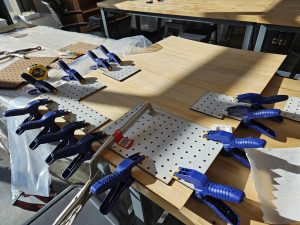
Thanks to the wood bending, the inside of the board was glued together with way more clamps than necessary.
Zoe’s Status Report – 4/20/24
This week I made considerable progress on the project. First, I finished my app. I made the Bluetooth connection work from my app to the mat, so now when I click on a specific song on the app, the mat microcontroller receives the corresponding song number. It works reliably well when the correct procedure is followed. Tomorrow I am going to work on testing this connection, to 1) check that the correct procedure always works, and 2) to find and fix edge cases where the connection might not work. I also made the app better looking by adding a font and splash screen, and removing an unnecessary page menu. In addition, I continued working on the other mat code. The mat should be completed soon, so then I can debug this code on the mat. Lastly, I started working on the connection between the mat and the lock Arduino. I am going to complete these in the next few days, so that I have time to perform all of the testing that I want to by the end of the week.
I am on time with my work, because I can get everything done that I need to this week (I don’t have anything else to do, so I have a lot of time).
As you’ve designed, implemented and debugged your project, what new tools or new knowledge did you find it necessary to learn to be able to accomplish these tasks? What learning strategies did you use to acquire this new knowledge?
I’ve learned a lot of new things while working on this project. First, I had never made any sort of web or mobile app before. My only experience with them was when we hacked into websites for Intro to Computer Security, which gave me a very limited understanding of JavaScript and web apps. So, I had to learn about JavaScript, React Native, Expo, and Android development tools mostly from scratch. In addition, I’ve never worked with Bluetooth before. I didn’t know what it was besides a convenient, magical connection between two devices. I had to learn about how the protocol works (scanning, advertising, services, characteristics, etc.) and how it is implemented in apps and different microcontroller and module architectures. I wouldn’t have been able to understand any of this new information without my experience from my other classes. First of all, a lot of the new information is similar to or draws on previous information that I’ve learned. For example, I need to use AT commands for the Bluetooth module in the lock. I was confused with what these were, because the documentation was really bad and didn’t explain anything, but then I realized that we had created AT commands for a lab in Embedded Systems. The method of using UART is different on the Arduino versus the stm32 I had used previously, but my foundation in the area has allowed me to learn this new protocol. I have learned most of the new information by finding documentation online and by reading forums where people asked questions similar to the ones I had. There is so much that I have learned by needing to debug errors and finding information online related to the errors. I have realized that I am a very hands-on learner, which has been tough when dealing with code for the mat and the lock, because Brooke and Jada need their microcontrollers for their work too, so I don’t always have access to them.
Jada’s Status Report – 4/20/24
For the past two weeks, I have ordered additional parts that should bring the lock sub-system to completion. This included amplifier transistors, more robust speakers, and servo motors. Addressing the most pressing issue of the lock over the last two weeks, the lack of speaker amplification, I used an example circuit, the amplifier transistor I ordered, and various resistors and capacitors sourced from the 18-220 lab to build an amplifier circuit, modifying the resistance and capacitance values in attempts to improve the overall sound quality and volume. There is still some room for improvement here, and I hope to reach out to Prof. Sullivan to discuss possible adjustments if time permits. If I don’t have time, and since this is now a lower-priority item, the current speaker setup is sufficient for the final demo. I also added an elementary “song selection” function to the main lock code to select from different songs that are stored on the microSD card. In terms of testing the speaker, I downloaded a decibel reader onto my phone and checked for a safe reading (<75dB) at 6″, 1′, 2′, and 3′ away from the speaker, uncovered. All were under 75dB, and the 6″ reading is included in the images below.
Addressing the issue of the solenoid lock not having sufficient power and being an unclear indicator of the lock being locked or unlocked, the servo motor will soon replace the solenoid. The servo requires much less power and does not need constant power to be “unlocked”, meaning the system can be more efficient. It is also easy to make more clear with the servo what is “locked” and what is “unlocked.”
Another key item I began was testing possible coverings for the keypad to add another layer of security. With Brooke’s help, I was able to 3D print a 0.5mm thick sheet to tape over the keypad and hide the numbers. While the keypad still functions fully with this cover, I am unsure if it will be implemented in the final demo.
Every module needed for the lock is now physically added to the main circuit, aside from the servo which will replace the solenoid tomorrow. My next steps will be to move the amplifier circuit to a much smaller breadboard to consolidate space, solder any connections that I haven’t done yet, laser cut a box to act as a housing for the lock electronics, and 3D print a small part to connect to the servo and act as the lock piece that moves in and out. I am not a mechE, however, so I doubt I will be able to create a simple box or door to accompany the lock in a sufficiently short amount of time.
All of these tasks can be completed in this upcoming week, so I feel that I am on track to completing my tasks for the project. However, I am concerned about testing the full BeatLock system, as we are still working on connecting the three sub-systems. To catch the team up this week, I’m hoping to have the lock completely ready at the beginning of the week for Zoe to work on the Bluetooth functionality when she is ready to work on the connection between the mat and the lock.
Additional Considerations: Learning Strategies
As I have gone throughout this process of creating the lock subsystem this semester, I have gained new knowledge about how to work with Arduino, specifically the Uno R3, its specific architecture, and how to be flexible with finding modules to accommodate it, such as the Bluetooth and microSD card reader modules. My strategy throughout the semester for each new addition has been to read datasheets when available to get a sense of different design parameters and how the item generally functions, then to move from that to looking for examples of the item being used, either through reading through example code to get an idea of function or through videos of someone walking the viewer through an example circuit with the item used. From here, I tend to debug and optimize, using strategies such as googling Arduino IDE errors for understanding, reading forums when I run into specific hardware issues, and even downloading multiple libraries to try to get a specific component working. I have also learned through the short time span of this class that while certain ideas in theory will work best, when trying to debug for two weeks leads nowhere, it is time to pivot and choose another plan; this can specifically be seen in my attempts at getting the Seeed Xiao to work and switching to the Arduino Uno R3 after being unsuccessful.
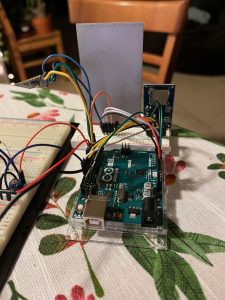
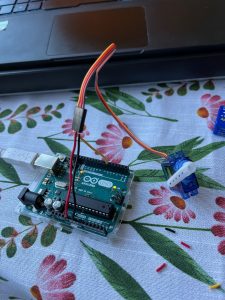
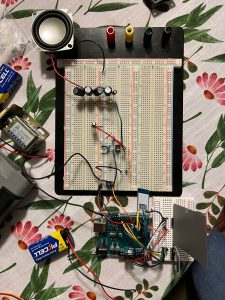
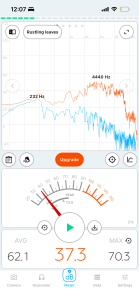
Team Status Report – 4/6/24
- What are the most significant risks that could jeopardize the success of the project? How are these risks being managed? What contingency plans are ready?
The main risk still appears to be the Bluetooth connection between each subsystem, as we are still unable to thoroughly test that. There are a few more minor issues mentioned in Jada’s status report regarding the speaker and BT module, which controls song selection and audio output; however, those will likely be solved within the upcoming week. Another risk is that the mat system has not yet been put together (physical mat, electronics, and code), so there has been no testing to see if everything works together. With time running out, we will have fewer options if we realize there is something wrong with our system and we need to change something.
No changes have been made to the system’s existing design within the past week.
Updated Schedule:
April 8 – April 15
Finish mat construction: Brooke and Jada assist when needed
Play song through lock: Jada
Order rubber covering and battery for mat for installation: Brooke
Get BT connection between app, mat, and lock: all
3D print lock housing: Jada
April 15 – April 22
Get one dance functioning on the complete system: all
Testing: all
Now that you have some portions of your project built, and entering into the verification and validation phase of your project, provide a comprehensive update on what tests you have run or are planning to run. In particular, how will you analyze the anticipated measured results to verify your contribution to the project meets the engineering design requirements or the use case requirements? Validation is usually related to your overall project and is likely to be discussed in your team reports.
Additional Discussion:
The following tests have been or will be run on the comprehensive system for validation:
- Bluetooth connection—the connections between the three subsystems will be verified by checking for a connection. This will be more rigorously tested once the system is mostly completed by checking for connection when the user with the phone app walks up to the mat and locks.
- Timing and consistency—The timing between the song and the dance detection will be tested for consistent starting. They do not need to start precisely at the same time, but they need to start consistently at the same amount of time apart. This will be done by repeatedly measuring timing.
- Backup entry – The backup entry method (keypad) will be tested for entry time (under ten seconds) using a stopwatch.
- User experience—the dance experience will be tested and reviewed by multiple third-party people to gain unbiased opinions. We have already used this type of testing to help us make decisions regarding the size of the mat, and we plan to use it to test the dance experience once we have made the mat functional.
